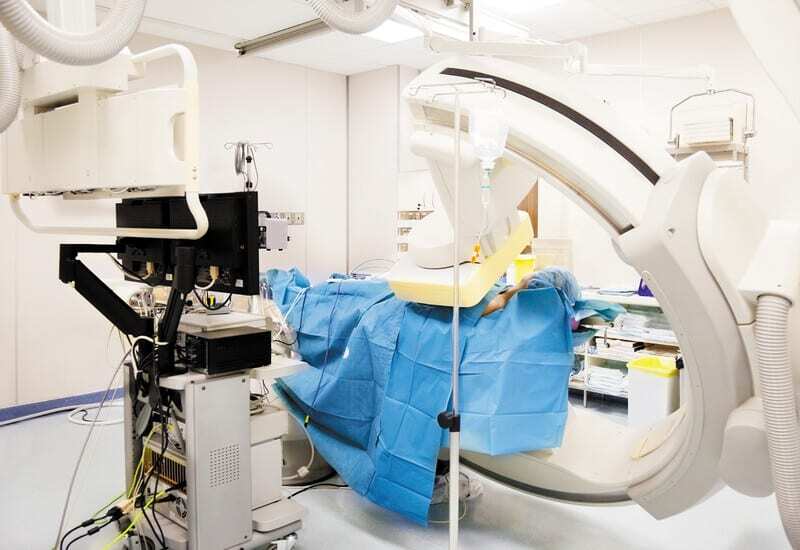Marc Darrow, MD, JD.
Everyday we get many emails. In many of these emails the person asking a question sends us their cervical neck MRI findings. That is all they send: A cut and paste of their MRI report. They never say what their pain is like, how this neck pain is affecting their day to day quality of life, or any other glimpses into how this chronic neck pain is hurting them. The email they send is all about their neck MRI interpretation. Our own clinical findings and that of researchers is that maybe your neck pain should not be all about your MRI. It should be about you.
Article summary:
- Is the neck MRI really showing what my problem is?
- Patients are treated based on what the MRI said, not what they patient said was wrong with them.
- Research: “It is difficult to rule out the possibility of bias; radiological findings may influence surgeon’s decision making.”
- Is “Unstable” Spondylolisthesis Really Unstable?
Is the neck MRI really showing what my problem is?
Interpreting MRIs can be challenging. In a recent study from March 2019, (1) researchers found the most prevalent MRI findings were:
- Cervical foraminal stenosis (77%)
- The foramen is the gap or passages between the vertebrae that the nerves pass through. If this passageway is made narrower by bony overgrowth there is obviously less space for the nerves to pass through. Over time this passageway can close up enough that the nerves are “pinched.” Why does the bone overgrow? Bone overgrowth can be caused by spinal instability. When the cervical spine is unstable, loose, or wobbly, neck moves in an unnatural motion. Cervical neck instability is generally caused by stressed, weakened and damaged spinal ligaments.
As bad as it may look on an MRI, cervical foraminal stenosis, may not be causing the patient any problems: We have seen this clinically and researchers have seen it and reported it in their published studies:
A January 2023 paper (2) had patients create a drawing showing where their neck hurt. Then this drawing was matched to an MRI of their spine. The radiculopathy level determined from the pain drawings showed poor overall agreement with MRI. “This study revealed a lack of agreement between the segmental level affected determined from the patient’s pain drawing and the affected level as identified on MRI. “The large overlap of pain and non-dermatomal distribution of pain reported by patients likely contributed to this result.”
For some people there was a rush to surgery because of what their MRI said. Doctors at Yale University suggested in 2016 (3) to doctors that they should not solely rely on MRI readings when evaluating patients for neck pain treatment because the MRI may suggest a surgery that is not really needed. The researchers of this study wrote: “Physicians should be aware of inconsistencies inherent in the interpretation of cervical MRI findings and should be aware that some findings demonstrate lower agreement than others (in recommending surgery).”
Citing the 2016 research is an October 2023 research paper (4). Some confusion on MRI assessments of changes in the cervical spine are presented. The authors write: “There is considerable variability among radiologists when grading spinal canal and foraminal stenosis on MRI. However, to date, studies have not evaluated radiologists’ agreement when assessing interval change in cervical spine stenoses.” Simply, variation in the MRI interpretation, but what about when there are changes to the neck as determined by a second MRI. Do the radiologists agree that there are changes?
Here are the findings and the clinical implications:
- 40 cervical MRI exams and 40 corresponding MRI follow-ups were assessed.
- Blinded radiologists had high agreement when assessing for change in spinal canal and foraminal stenosis on follow-up cervical spine MRIs.
- However, “because of inter-rater variability in stenosis grading, reports that do not emphasize change assessment, may imply change that is not truly present. For clarity and consistency in reporting of cervical spine stenoses, change assessment should be emphasized and added to structured reporting templates.”
The patient and their doctors may not be getting the whole MRI story.
A February 2024 study (10) found that patients were not sure if their health care providers were helping their situation or making it worse. “Participants described the uncertainty they experienced as a result of the unpredictable nature of degenerative cervical radiculopathy and the important role that health care providers play in their journey with degenerative cervical radiculopathy. Health care providers were seen acting as either a facilitator or a barrier to their recovery.”
Patients are treated based on what the MRI said,
not what they patient said was wrong with them.
In the Clinics in orthopedic surgery,(5) surgeons wrote: “Cervical foraminal stenosis is one of the degenerative changes of the cervical spine; however, correlations between the severity of stenosis and that of symptoms are not consistent in the literature. Studies to date on the prevalence of stenosis are based on images obtained from the departments treating cervical lesions, and thus patient selection bias may have occurred.”
The surgeons suggested that the patient was treated based on what the MRI said, not what they patient said was wrong with them. Perhaps this is why when people send me an email, some never suggest what their symptoms are, only what their MRI said. In this study, the surgeons also suggest that patients may have been sent to surgery that was suggested based on the bias of the MRI interpretation. A surgery the patient may have not needed at all.
Returning to our initial overview of most prominent MRI readings, next came
- uncovertebral arthrosis (74%)
- This is wear and tear damage occurring at the uncovertebral joint or Luschka’s joint, located on each side of the four cervical vertebrae at C3 to C7 in the cervical spine. This is where bone spurs most commonly develop.
- and disc degeneration (67%)
- This is of course are the problems herniated or pinched nerves.
Research: “It is difficult to rule out the possibility of bias;
radiological findings may influence surgeon’s decision making.”
Let’s look again at the study in the Clinics in orthopedic surgery.
- “Cervical neuromuscular disease is manifested by symptoms in specific neuromuscular regions of the upper limbs, and radiating pain is mostly caused by cervical nerve root compression due to stenosis of the cervical vertebrae. In the presence of progressive neurological deterioration, intractable pain, signs of myelopathy, fracture, instability, or ligamentous injury, and bone anomalies or destruction are associated with surgical indications.
- “However, (this can all be) asymptomatic. To determine the affected level that requires cervical spine surgery, the patients undergo neurological and physical examinations and then both CT and magnetic resonance imaging (MRI); if the results do not match, additional neurophysiological testing is required to determine the affected level. However, if neurological examinations are performed after radiological examinations, it is difficult to rule out the possibility of bias; radiological findings may influence surgeon’s decision making.”
Sometimes surgery is recommended. But should it be for you?
This is a good question and one that certainly needs to be answered inside an examination room. However, returning to our initial overview of the most prominent MRI readings, let’s look at the least prevalent finding:
- nerve root compromise or compression (2%)
Now if you are in that 2% there is a strong chance that you are suffering from cervical radiculopathy or pain from the nerves. In theses cases surgical options may have to be considered, but, a second opinion looking for non-surgical options may also be warranted.
In my article on this website: How fast does degenerative disc disease progress in the neck? I write that I regularly see patients who have been told by another doctor that they need a neck surgery to prevent the further degeneration of their cervical spine. Some of these patients are very frightened by what their doctor told them. Some were told that if their symptoms progress they could risk permanent damage to their ability to function maybe to the point of paralysis. I show that research has strongly suggested that many patients decide on cervical fusion surgery because they fear a progression of their problem that will lead to permanent disability. However, follow-up data on patients with degenerative disease of the upper (cervical) spinal vertebrae show little or no evidence of worsening degeneration over time.
Is “Unstable” Spondylolisthesis Really Unstable?
For many patients with “unstable” cervical degenerative spondylolisthesis, observation may be a better choice than surgery, according to the researchers who conducted a study described below. (6)
Degenerative spondylolisthesis refers to a slipped vertebrae caused by vertebral fracture or attenuation of the pars inarticularis, a part of the vertebra. Because spondylolisthesis is commonly thought to result in instability of the cervical spine, spinal fusion surgery (arthrodesis) is sometimes considered the appropriate treatment. The authors of this study wrote: “Our results suggest that the majority of these patients may be stable and do not develop progression of disease or catastrophic neurologic deficits.”
The researchers analyzed the natural history of cervical degenerative spondylolisthesis in 27 patients. The 16 men and 11 women in the study underwent cervical spine radiographs (x-rays) on two occasions at least two years apart. The patients’ average age at the time of the initial radiograph was 59 years; average time to the follow-up radiographs was 39 months. Measurements on the paired radiographs were carefully compared to determine whether and how much the cervical slippage increased over time. Initial x-rays showed instability (at least two millimeters of displacement between vertebrae) in several patients. However, during follow-up, none of the patients showed further progression, defined as additional displacement of two millimeters or more. The average progression was only about one-half millimeter. Twenty-one patients had backward displacement (retrolisthesis) of the cervical vertebrae, while six had forward displacement (anterolisthesis). The patients with retrolisthesis had somewhat greater slippage during follow-up; however, none had a dislocation or suffered neurological damage.
No Progression of Slippage or Symptoms
Of 16 patients who had symptoms such as neck pain or sensory abnormalities at the initial visit, most were successfully managed without surgery. Of the 11 patients who were initially symptom-free, none developed symptoms during follow-up. The study is one of the few to look at the natural history of the results and suggests that at medium-term follow-up, the conditions appear to be “relatively stable” in most patients. Dr. Park (the lead author of this study) and colleagues write: “This begs the question, if an ‘unstable’ spine does fine without treatment, is it really unstable?
Our results suggest that the majority of these patients may be stable and do not develop progression of disease or catastrophic neurologic deficits.”
The researchers acknowledge some important limitations of their study—particularly the small number of patients and relatively short follow-up period. However, the results suggest that for many patients, cervical spondylolisthesis is a nonprogressive condition that does not necessarily require surgical treatment. The authors conclude, “In the absence of neurologic symptoms, we recommend observation of patients with degenerative spondylolistheses of the cervical spine.”
A 2018 paper cited Dr. Park’s 2013 research by saying “In 2013, Park and his colleagues, studied the natural history of 27 patients with degenerative cervical spondylolisthesis and reported that they seemed to remain stable from 2 to nearly 8 years of follow-up. Reports concerning cervical spondylolisthesis have increased, but the research is still insufficient to clarify the pathology and proper treatment choice for this disease.” (7) The traditional and most used treatment is the “watch and wait” means of assessment if the patient is stable or getting worse.
Follow up research on progression of cervical spine degenerative disc disease
Dr. Park and his fellow researchers issued a follow up study in 2019. (8) What the research team continued to define is what is the progression for cervical spine slippage. They noted that in their previous study described above that 2- to 7-year follow-up showed that degenerative spondylolisthesis of the cervical spine did not progress. The purpose then of this study was to see if longer-term follow-up would reveal that these patients neck slippage actually do progress over time.
Examining a group of 218 cervical spine patients, who did not have the cervical spine surgery, the doctors assessed the progression of disc slippage at least five years later, though the average follow up of this patient base was six and one-half years.
- A finding was progression of translation was not related to the presence of spondylolisthesis or the severity of translation at the initial evaluation, but was more common in the elderly and in the patients with anterior translation than those with posterior translation at the initial evaluation. In addition, progression of spondylolisthesis was not correlated with any change of symptoms. Conclusion: Progression of cervical spondylolisthesis is not related to the presence of spondylolisthesis at baseline.
In July 2023, (9) doctors continued along this line of research by looking into whether cervical degenerative spondylolisthesis is associated with increased neck/arm pain and worse health. In reviewing patient data from 242 patients, the researchers could not suggest that degenerative spondylolisthesis caused increased baseline neck or arm pain. Instead, degenerative spondylolisthesis appears to be a relatively frequent (20% in this series) age-related condition reflecting radiographic, rather than necessarily clinical, disease. (it is seen more on MRI than as a cause of pain).
Summary
As many of you are already aware, MRI interpretations can be a long, hard to understand, somewhat frustrating thing for a patient to see and read. The MRI may also seemingly describes a lot of problems with a lot of terminology that can be considered frightening. This may, for many, cause unneeded anxiety and fear. I have been doing regenerative medicine for more than 27 years. Over the years we have been blessed to have helped many people with their neck pain. I have seen patients with varying degrees of degenerative cervical spine disease trying to avoid surgery, I have also seen patients after a cervical neck surgery with more challenges than before the surgery who, unfortunately, may have had a surgery that they did not need. The one thing many of these people had in common was a cervical neck MRI that suggested a lot more problems than the patient was actually having.
Contact us and related articles
If you have chronic neck pain, have had painkillers, physical therapy, and other conservative care options that have not helped, and, now you are being told to have surgery. We may be able to help reduce pain and increase function.
Regenerative medicine injections may be an alternative for you. Many people benefit from these treatments, but, they do not work for everyone. Will it work for you? Get a FREE phone consultation.
Call for a free phone consultation with our staff.
800-300-9300 or 310-231-7000 or email
References
1 Jensen RK, Jensen TS, Grøn S, Frafjord E, Bundgaard U, Damsgaard AL, Mathiasen JM, Kjaer P. Prevalence of MRI findings in the cervical spine in patients with persistent neck pain based on quantification of narrative MRI reports. Chiropractic & manual therapies. 2019 Dec;27(1):13.
2 Marco B, Evans D, Symonds N, Peolsson A, Coppieters MW, Jull G, Löfgren H, Zsigmond P, Falla D. Determining the level of cervical radiculopathy: Agreement between visual inspection of pain drawings and magnetic resonance imaging. Pain Practice. 2023 Jan;23(1):32-40.
3 Fu MC, Webb ML, Buerba RA, et al. Comparison of agreement of cervical spine degenerative pathology findings in magnetic resonance imaging studies. Spine J. 2016 Jan 1;16(1):42-8. doi: 10.1016/j.spinee.2015.08.026. Epub 2015 Aug 17.
4 Costello JE, Shah LM, Peckham ME, Stilwill SE, Safazadeh G, Hutchins TA. Time for change? Radiologists highly concordant assessing change in stenoses on follow-up cervical spine MRI. The neuroradiology journal. 2023 Oct;36(5):588-92.
5 Ko S, Choi W, Lee J. The Prevalence of Cervical Foraminal Stenosis on Computed Tomography of a Selected Community-Based Korean Population. Clin Orthop Surg. 2018 Dec;10(4):433-438. doi: 10.4055/cios.2018.10.4.433. Epub 2018 Nov 21.
6 Park MS, Moon SH, Lee HM, Kim SW, Kim TH, Suh BK, Riew KD. The natural history of degenerative spondylolisthesis of the cervical spine with 2-to 7-year follow-up. Spine. 2013 Feb 15;38(4):E205-10.
7 Aoyama R, Shiraishi T, Kato M, Yamane J, Ninomiya K, Kitamura K, Nori S, Iga T. Characteristic findings on imaging of cervical spondylolisthesis: analysis of computed tomography and X-ray photography in 101 spondylolisthesis patients. Spine surgery and related research. 2018 Jan 20;2(1):30-6.
8 Kundu B, Eli I, Dailey A, Shah LM, Mazur MD. Preoperative Magnetic Resonance Imaging Abnormalities Predict Symptomatic Adjacent Segment Degeneration After Anterior Cervical Discectomy and Fusion. Cureus. 2021 Aug 18;13(8).
9 Kaye ID, Sebastian AS, Wagner SC, Semenza N, Bowles D, Schroeder GD, Kepler CK, Woods BI, Radcliff KE, Kurd MF, Rihn J. No Difference in Neck Pain or Health-Related Quality Measures Between Patients With or Without Degenerative Cervical Spondylolisthesis. Global spine journal. 2023 Jul;13(6):1641-5.
10 Plener J, Mior S, Atkinson-Graham M, Hogg-Johnson S, Côté P, Ammendolia C. Information is power: a qualitative study exploring the lived experiences of patients with degenerative cervical radiculopathy. Pain. 2022 May 13:10-97.







